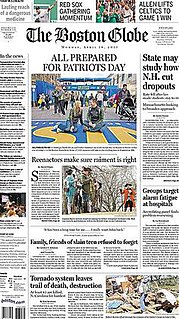
The Boston Globe is an American daily newspaper founded and based in Boston, Massachusetts, since its creation by Charles H. Taylor in 1872. The newspaper has won a total of 26 Pulitzer Prizes as of 2016, and had a total paid circulation of about 136,000 in the year ending in August 2016. The Boston Globe is the oldest and largest daily newspaper in Boston.

The Boston Post was a daily newspaper in New England for over a hundred years before it folded in 1956. The Post was founded in November 1831 by two prominent Boston businessmen, Charles G. Greene and William Beals.

State station is a subway station in Boston, Massachusetts. Located in downtown Boston, State is the transfer point between the MBTA Orange Line and the Blue Line, and one of four "hub stations" on the MBTA subway system.

The Old South Meeting House is a historic Congregational church building located at the corner of Milk and Washington Streets in the Downtown Crossing area of Boston, Massachusetts, built in 1729. It gained fame as the organizing point for the Boston Tea Party on December 16, 1773. Five thousand or more colonists gathered at the Meeting House, the largest building in Boston at the time.
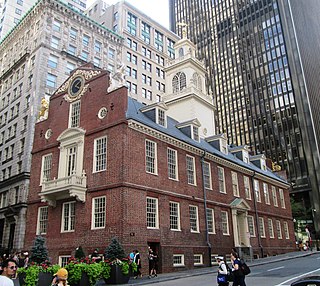
The Old State House is a historic building in Boston, Massachusetts, at the intersection of Washington and State Streets. Built in 1713, it was the seat of the Massachusetts General Court until 1798, and is one of the oldest public buildings in the United States. One of the landmarks on Boston's Freedom Trail, it is the oldest surviving public building in Boston, and now serves as a history museum that, through 2019, was operated by the Bostonian Society until January 2020. On January 1, 2020, the Bostonian Society merged with the Old South Association in Boston to form Revolutionary Spaces. The Old State House was designated a National Historic Landmark in 1960 and a Boston Landmark by the Boston Landmarks Commission in 1994.
The Yankee Quill Award is a regional American journalism award that recognizes a lifetime contribution toward excellence in journalism in New England. The award is bestowed annually by the Academy of New England Journalists, and administered by the New England Society of Newspaper Editors. It is considered the highest individual honor awarded by fellow journalists in the region.

The Gibson House Museum is an historic house museum located at 137 Beacon Street in the Back Bay neighborhood of Boston, Massachusetts. It preserves the 1860 Victorian rowhouse occupied by three generations of the Gibson family. The house was one of the first to be built in Back Bay, and has an unparalleled state of preservation that includes wallpaper, textiles, furnishings, and family artifacts and collections. Both the public and service areas of the house exhibit a high degree of preservation, and are viewable on tours. The property was designated a Boston Landmark in 1992 by the Boston Landmarks Commission and a National Historic Landmark in 2001.

The Old Corner Bookstore is a historic commercial building located at 283 Washington Street at the corner of School Street in the historic core of Boston, Massachusetts. It was built in 1718 as a residence and apothecary shop, and first became a bookstore in 1828. The building is a designated site on Boston's Freedom Trail, Literary Trail, and Women's Heritage Trail.
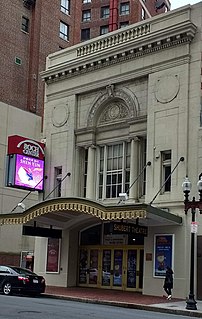
The Shubert Theatre is a theatre in Boston, Massachusetts, at 263-265 Tremont Street in the Boston Theater District. It opened on January 24, 1910, with a production of Shakespeare's The Taming of the Shrew starring E.H. Sothern and Julia Marlowe. Architect Thomas M. James designed the building, which seats approximately 1,600 people. Originally conceived as The Lyric Theatre by developer Charles H. Bond, it was taken over by The Shubert Organization in 1908 after Bond's death.
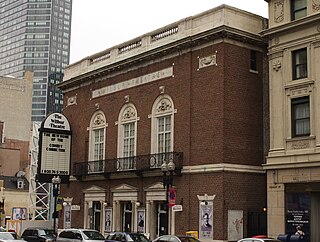
The Wilbur Theatre is an historic performing arts theater at 244–250 Tremont Street in Boston, Massachusetts. The Wilbur Theatre was originally opened in 1914, but was revitalized in 2008. The Wilbur Theatre dwells in the heart of Boston's historic theater district and is known for hosting live comedy and music.

The Bostonian Society was a non-profit organization that was founded in 1881 for the purpose of preventing the Old State House from being "moved brick by brick" from Boston, Massachusetts to Chicago, Illinois. Determined to save the historic building that was the site of the Boston Massacre and the place for the proclamation of the Declaration of Independence in Massachusetts, a group of citizens banded together formed "Boston's first successful historic preservation movement". The Bostonian Society no longer exists. On January 1, 2020, the Bostonian Society merged with the Old South Association in Boston to form Revolutionary Spaces.
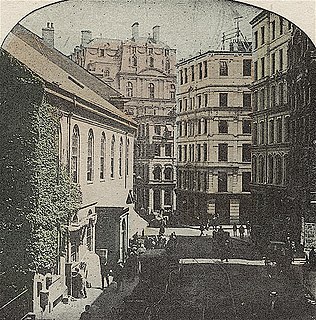
Milk Street is a street in the financial district of Boston, Massachusetts. It was one of Boston's earliest highways. The name "Milk Street" was most likely given to the street in 1708 due to a milk market at the location, although Grace Croft's 1952 work "History and Genealogy of Milk Family" instead proposes that Milk Street may have been named for John Milk, an early shipwright in Boston. The land was originally conveyed to his father, also John Milk, in October 1666.

Samuel Stillman Pierce (1807–1881) was a grocer in Boston, Massachusetts, who established the S.S. Pierce company in 1831.

Pi Alley in Boston, Massachusetts, is located off Washington Street, near the Old City Hall on School Street. The origin of the short street's name remains in question. It may be called "Pi Alley" "because of the dumping into it of the pied type from newspaper composing rooms years ago", or "Pie Alley" "because of restaurants that sold a piece of pie and a cup of coffee for a nickel." It is also known as Williams Court, Savage's Court, Peck's Arch, and Webster's Arch.

Cornhill was a street in Boston, Massachusetts, in the 19th and 20th centuries, located on the site of the current City Hall Plaza in Government Center. It was named in 1829; previously it was known as Market Street (1807–1828). In its time, it comprised a busy part of the city near Brattle Street, Court Street and Scollay Square. In the 19th century, it was the home of many bookstores and publishing companies. As of 1969, Cornhill exists as 144 feet along the edge of City Hall Plaza.

Tremont Row (1830s-1920s) in Boston, Massachusetts, was a short street that flourished in the 19th and early-20th centuries. It was located near the intersection of Court, Tremont, and Cambridge streets, in today's Government Center area. It existed until the 1920s, when it became known as Scollay Square. In 1859 the Barre Gazette newspaper described Tremont Row as "the great Dry Goods Street of Boston."

East Somerville is a planned light rail station on the MBTA Green Line D branch in Somerville, Massachusetts. The station will consist of one island platform, which will serve the D branch's two tracks.
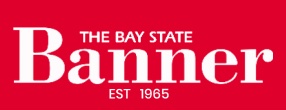
The Bay State Banner is an independent newspaper primarily geared toward the readership interests of the African-American community in Boston, Massachusetts. The Bay State Banner was founded in 1965 by Melvin B. Miller who remains the chief editor and publisher. In 2015, the publication celebrated its 50th anniversary serving the region's minority-oriented neighborhoods.
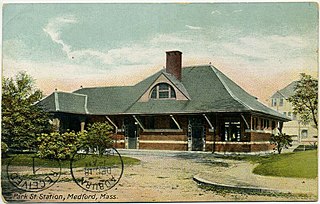
The Medford branch was a railroad branch line of the Boston and Maine Railroad (B&M). Located entirely within Medford, Massachusetts, the branch connected Medford Square to the B&M main line. It had passenger service from 1847 to 1957, with freight service on the inner part of the line until 2010.


























